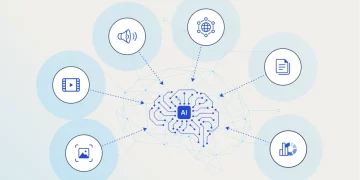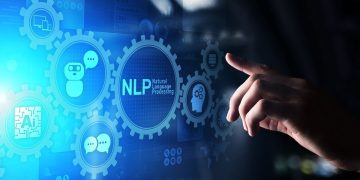Introduction:
In today’s digital age, Artificial Intelligence (AI) is transforming businesses, enabling them to streamline operations, improve customer experiences, and create innovative products and services. However, the successful implementation of AI projects requires significant computing power, scalability, and flexibility—resources that can be expensive and complex to manage in-house. This is where cloud computing plays a pivotal role.
Cloud computing provides businesses with on-demand access to computing resources, such as processing power, storage, and networking, without the need for heavy upfront investments in hardware. By leveraging cloud platforms, enterprises can quickly scale their AI projects, run complex algorithms, and collaborate more effectively across teams, all while minimizing operational costs.
In this article, we will explore how enterprises can effectively utilize cloud computing resources to accelerate AI project implementation. We will cover the benefits, key considerations, and strategies that businesses can adopt to maximize their AI initiatives using cloud technologies.
1. Understanding the Role of Cloud Computing in AI
Cloud computing allows businesses to rent computing resources through various cloud service providers, offering flexibility and scalability that on-premise infrastructures simply can’t match. For AI projects, these resources can be crucial in managing large datasets, training complex models, and running computationally intensive processes.
Cloud services are typically offered through three main models:
- Infrastructure as a Service (IaaS): Provides virtualized computing resources over the internet, such as virtual machines and storage.
- Platform as a Service (PaaS): Delivers a platform allowing customers to develop, run, and manage AI applications without dealing with infrastructure complexities.
- Software as a Service (SaaS): Offers ready-made AI software and tools hosted in the cloud, making it easier for businesses to implement AI without deep technical expertise.
Prominent cloud service providers like Amazon Web Services (AWS), Google Cloud Platform (GCP), and Microsoft Azure offer a wide range of cloud-based tools and resources tailored specifically for AI projects, such as machine learning models, AI services, and data storage solutions.
2. Benefits of Using Cloud Computing for AI Projects
2.1. Scalability and Flexibility
AI projects, particularly those involving deep learning, require significant computational power and storage capacity. Cloud computing provides an on-demand, scalable solution, allowing enterprises to access as much or as little computational power as they need. This elasticity ensures that businesses only pay for the resources they use, avoiding costly over-provisioning of hardware.
For example, if an enterprise is running a large-scale machine learning model that requires intensive processing power, cloud resources can be scaled up during the training phase, and scaled down once the project reaches production. This reduces costs and optimizes resource usage.
2.2. Cost-Effectiveness
Maintaining and upgrading AI infrastructure can be expensive. Enterprises often need high-performance computing hardware, such as Graphics Processing Units (GPUs) or Tensor Processing Units (TPUs), which can incur significant capital expenditures. Cloud providers, however, offer these specialized resources on a pay-as-you-go basis, eliminating the need for enterprises to make large upfront investments.
Additionally, cloud computing can reduce operational costs by consolidating resources and improving efficiency. Companies do not need to invest in costly infrastructure maintenance or worry about hardware failures, as these are managed by cloud providers.
2.3. Accelerated Time-to-Market
AI projects often involve long development cycles, especially when training models on large datasets. Cloud computing accelerates the process by providing fast access to high-performance hardware and pre-built machine learning models and frameworks. Cloud platforms like AWS SageMaker, Google AI Platform, and Azure Machine Learning offer ready-to-use AI tools that allow enterprises to quickly experiment, prototype, and deploy models.
Additionally, by utilizing cloud-based collaboration tools, teams can work together seamlessly across different locations, leading to faster development cycles and more efficient project execution.
2.4. Access to Advanced AI and ML Tools
Leading cloud service providers offer a vast array of AI and machine learning tools designed to simplify the development process. These tools are powered by cutting-edge algorithms and pre-trained models, which can significantly reduce the time required to build and deploy AI systems.
Some of the tools available include:
- AWS Deep Learning AMIs (Amazon Machine Images): Pre-configured images that provide optimized environments for deep learning frameworks like TensorFlow, PyTorch, and Apache MXNet.
- Google AI Hub: A platform that allows developers to access AI models, frameworks, and datasets that can be used directly in their AI projects.
- Microsoft Azure AI Services: Offers tools like Azure Cognitive Services and Azure Machine Learning Studio for building, training, and deploying AI models.
These tools enable enterprises to leverage advanced AI capabilities without requiring specialized knowledge in AI research or development.
2.5. Security and Compliance
AI projects often involve handling sensitive data, such as customer information, healthcare records, or financial data. Cloud providers offer robust security protocols, including data encryption, identity and access management, and compliance certifications, which ensure that AI applications remain secure and compliant with regulations like GDPR, HIPAA, and others.
For example, AWS, Google Cloud, and Microsoft Azure have multiple layers of security in place, including multi-factor authentication, firewalls, and regular security audits to help businesses protect their AI applications and data.
3. Key Considerations for Leveraging Cloud Resources in AI Projects
While cloud computing offers several benefits, enterprises must carefully consider their needs and choose the appropriate cloud resources for their AI projects. Below are key factors to keep in mind when planning the use of cloud computing for AI implementation:
3.1. Choosing the Right Cloud Provider
Different cloud providers offer varying capabilities and specialized services. Enterprises should choose a provider that best aligns with their AI needs, whether that’s in terms of compute power, AI tools, or data storage solutions.
For instance:
- AWS is known for its extensive machine learning services, including SageMaker for model development and deployment.
- Google Cloud is highly regarded for its machine learning services, particularly its TensorFlow support and AI-powered tools.
- Microsoft Azure offers robust AI development tools and a comprehensive suite of machine learning services.
Enterprises should evaluate the specific AI tools, pricing structures, and regional data centers provided by each cloud provider to select the best fit for their needs.
3.2. Data Storage and Management
AI projects rely on large volumes of data for training and testing models. Proper data storage and management are essential to ensure that AI systems perform optimally. Cloud platforms offer scalable storage solutions, such as object storage, block storage, and data lakes, which are critical for storing vast amounts of data.
For example, Amazon S3 (Simple Storage Service) and Google Cloud Storage offer highly scalable, secure, and cost-effective storage options that allow businesses to manage their data effectively while ensuring easy access for their AI applications.
3.3. Model Training and Optimization
Training AI models can be resource-intensive and time-consuming. Cloud computing helps enterprises speed up this process by providing access to GPUs and TPUs, which are specifically designed for parallel processing required in machine learning tasks.
Enterprises can take advantage of auto-scaling and distributed training capabilities in the cloud to efficiently distribute workloads across multiple machines. This approach allows models to be trained faster, leading to quicker iteration and model improvement.
3.4. Cost Management and Optimization
While cloud computing can save enterprises significant upfront costs, managing cloud resources effectively is crucial to avoid overspending. Cloud providers offer cost management tools, such as AWS Cost Explorer, Google Cloud Billing, and Azure Cost Management, that allow enterprises to track usage, identify inefficiencies, and optimize their cloud spending.
Enterprises should also consider using spot instances or reserved instances for cost optimization, which allow them to take advantage of unused cloud resources at a lower price.

4. Best Practices for Accelerating AI Projects Using Cloud Computing
4.1. Leverage Pre-built AI Models and APIs
Cloud providers offer a variety of pre-trained AI models and APIs for tasks such as image recognition, natural language processing, and voice recognition. By utilizing these pre-built models, enterprises can bypass the time-consuming process of training models from scratch and quickly deploy AI-powered features.
For example, Google Cloud Vision API allows enterprises to quickly integrate image recognition capabilities into their applications without needing to build a custom model.
4.2. Automate Model Deployment with CI/CD Pipelines
Continuous Integration (CI) and Continuous Deployment (CD) pipelines can be integrated into the cloud environment to automate the testing, validation, and deployment of AI models. Cloud platforms such as AWS CodePipeline and Azure DevOps provide seamless CI/CD tools that help automate the entire lifecycle of AI models, from development to deployment.
This approach helps enterprises accelerate the time-to-market for AI solutions while ensuring consistency and reducing the risk of human error.
4.3. Collaborate Across Teams and Locations
Cloud computing fosters collaboration between data scientists, engineers, and business stakeholders by providing a centralized environment for project management and code sharing. Enterprises can take advantage of cloud collaboration tools like Google Colab, Jupyter Notebooks, and Microsoft Azure Notebooks to share code, data, and results in real-time, enabling cross-functional teams to work more efficiently.
5. Conclusion
Cloud computing has become an indispensable resource for enterprises looking to implement AI projects quickly, cost-effectively, and at scale. By leveraging cloud services, businesses can access powerful AI tools, scale their infrastructure as needed, and accelerate the development and deployment of AI models.
While choosing the right cloud provider, managing costs, and ensuring data security are crucial considerations, the potential benefits of using cloud resources—such as scalability, flexibility, and reduced operational costs—far outweigh the challenges. With the right strategies in place, enterprises can harness the power of cloud computing to drive innovation, enhance customer experiences, and achieve long-term success in their AI initiatives.











































